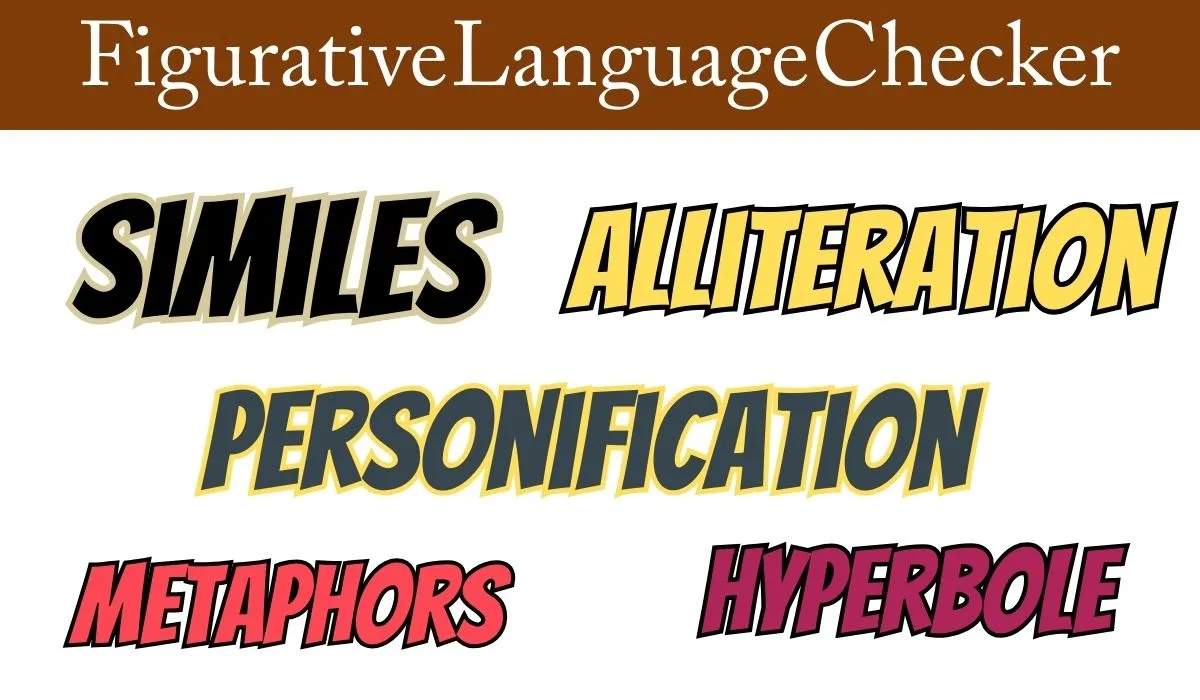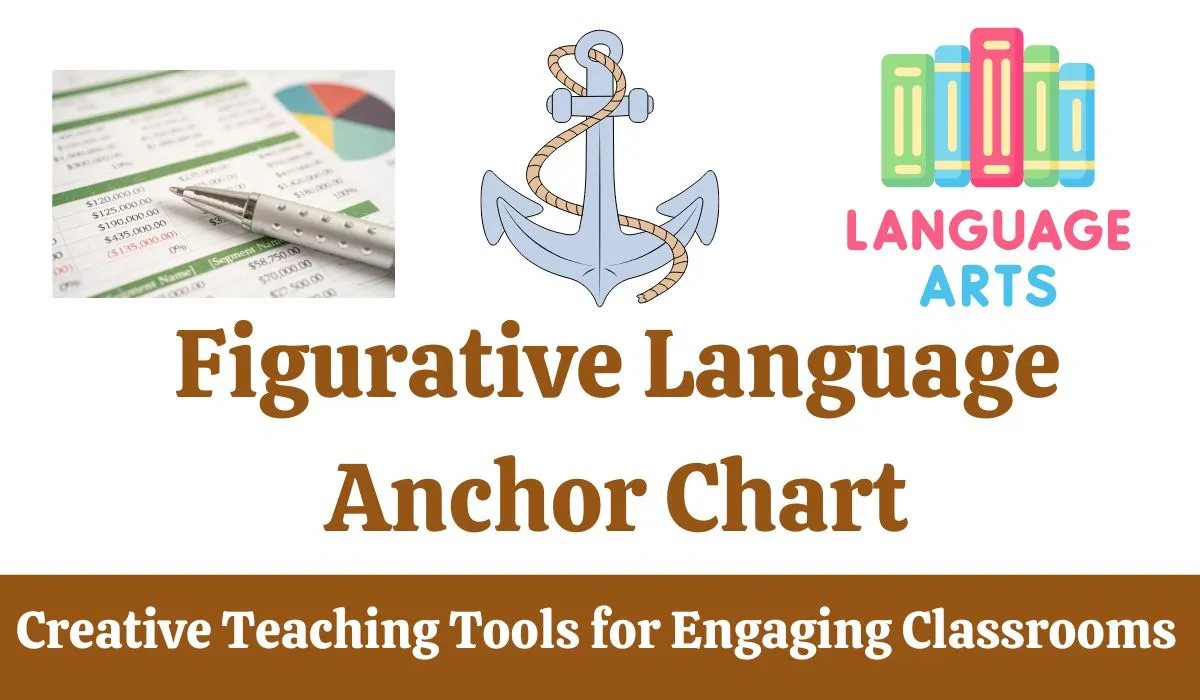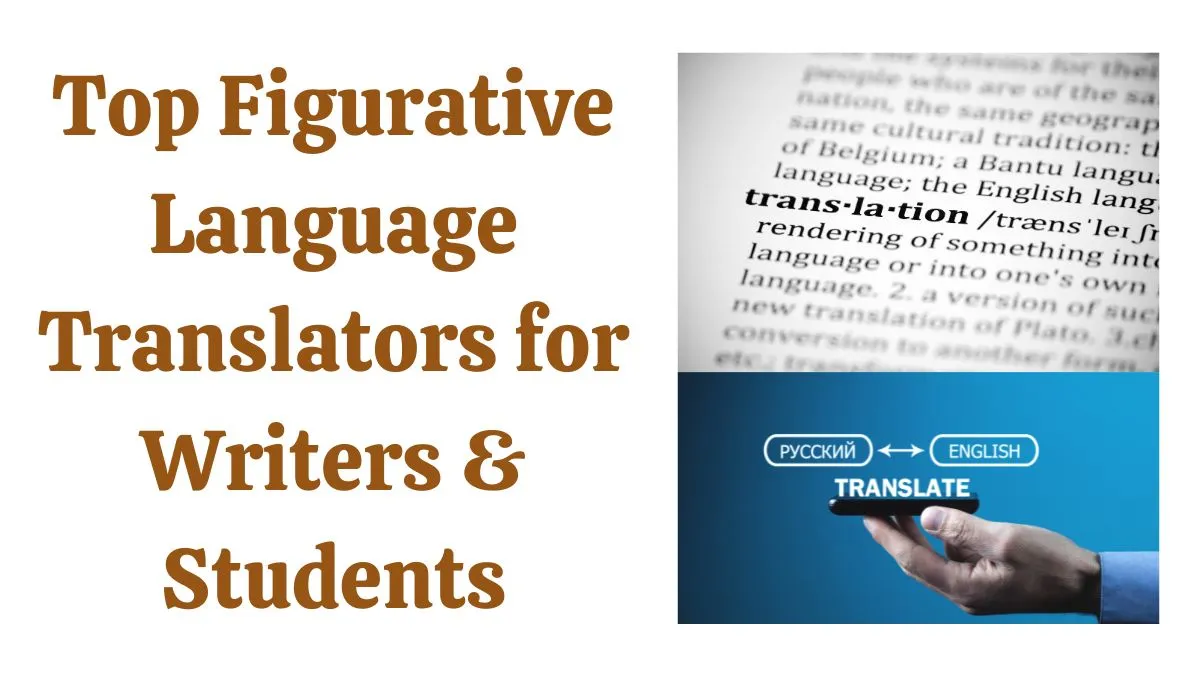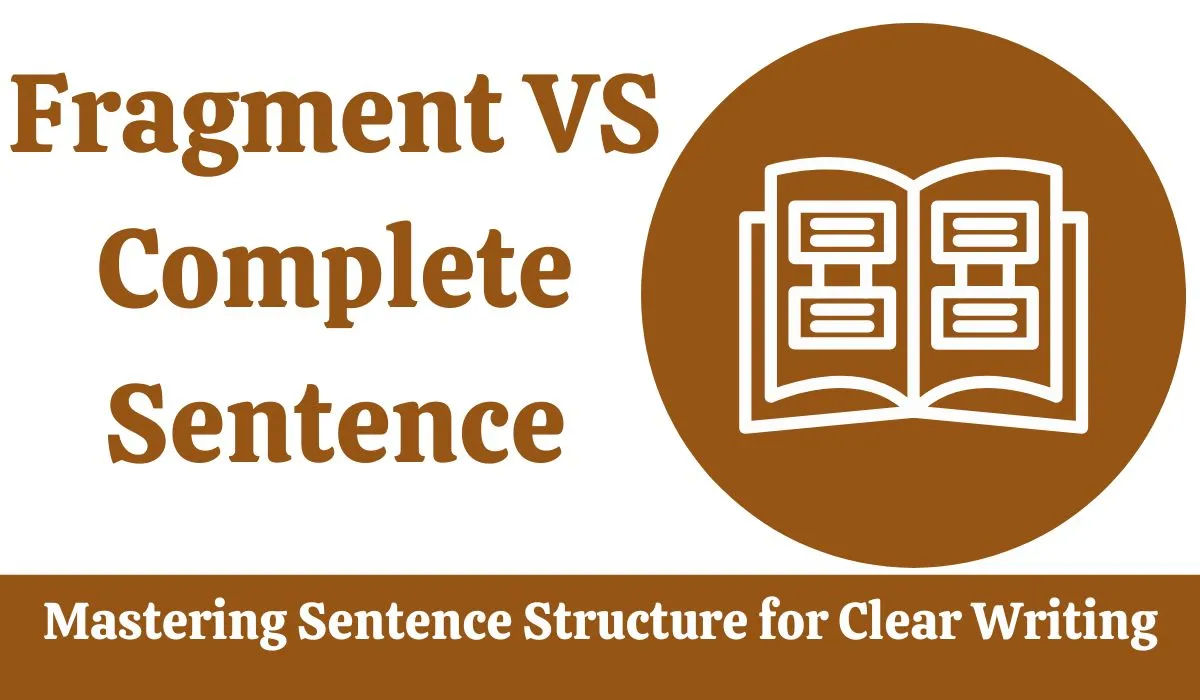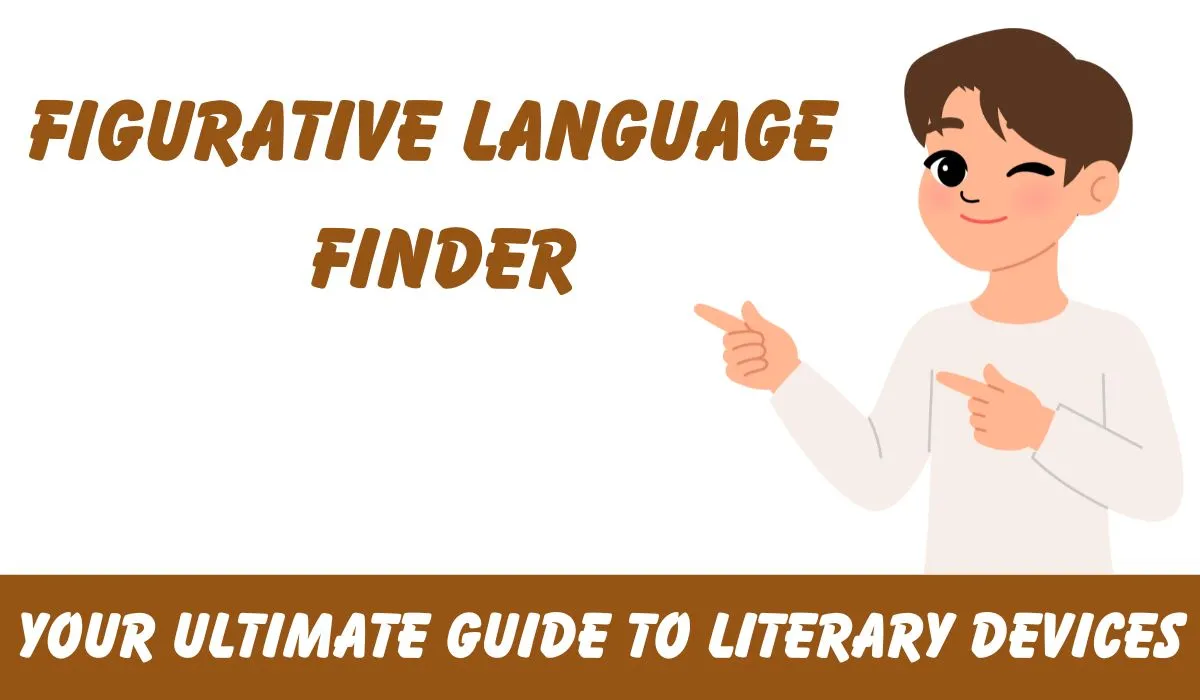Transform your writing with our figurative language detector. Try it now for captivating and enriched content!
Figurative Language Checker
Figurative language Checker is a cornerstone of creative and impactful writing. It goes beyond the literal meaning of words to evoke emotions, create vivid imagery, and engage readers on a deeper level. Writers, poets, advertisers, and educators use figurative language to convey complex ideas in a more relatable and memorable way. From metaphors and similes to hyperbole and personification, mastering these literary devices can elevate any piece of writing.
But identifying and analyzing figurative language manually can be time-consuming and subjective. Enter the figurative language checker—a digital tool designed to streamline the process and enhance both creative and analytical writing. In this article, we will explore the benefits, features, and importance of figurative language checkers, and why they have become essential for writers and educators alike.
What is a Figurative Language Checker?
A figurative language checker is a software tool or online platform that identifies and analyzes various literary devices in a text. It highlights instances of figurative language and offers insights into their usage. These tools are particularly helpful for:
- Students: To better understand literary techniques in literature and improve their writing.
- Writers: To refine their drafts and ensure their creative choices are impactful.
- Editors: To provide constructive feedback on the use of figurative language.
- Educators: To teach literary concepts more effectively.
Types of Figurative Language Detected
A good figurative language checker can identify a wide range of literary devices, including but not limited to:
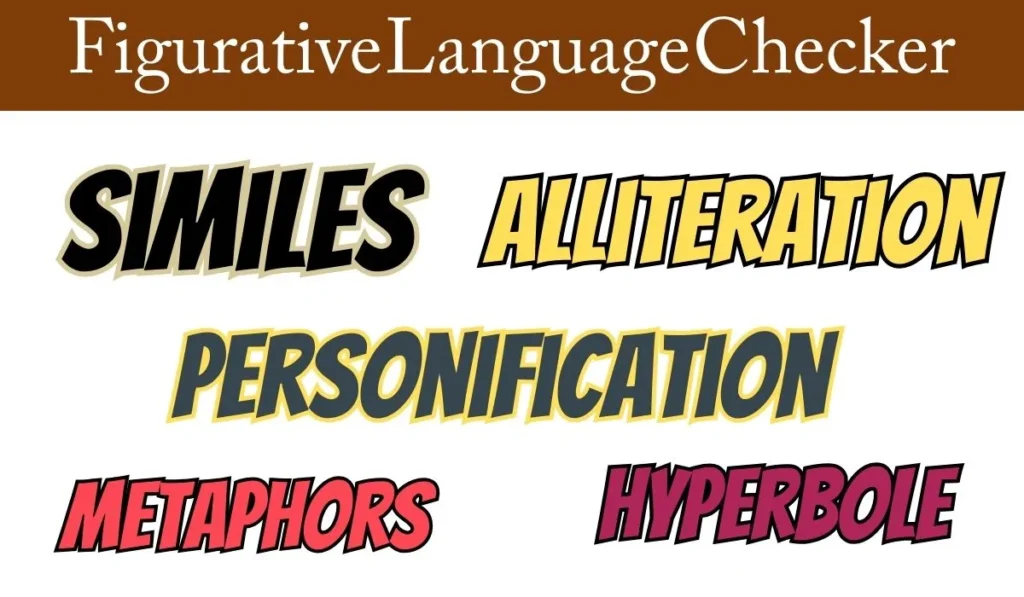
- Metaphors: Comparing two unrelated things without using “like” or “as.”
Example: “Time is a thief.” - Similes: Comparing two things using “like” or “as.”
Example: “Her smile was as bright as the sun.” - Personification: Assigning human traits to non-human entities.
Example: “The wind whispered through the trees.” - Hyperbole: Exaggerated statements for emphasis.
Example: “I’ve told you a million times!” - Alliteration: The repetition of initial consonant sounds.
Example: “She sells seashells by the seashore.” - Onomatopoeia: Words that imitate natural sounds.
Example: “The bees buzzed around the garden.” - Oxymoron: Combining contradictory terms.
Example: “Deafening silence.” - Irony: Expressing meaning by using language that signifies the opposite.
Example: “What a beautiful day,” during a storm.
By detecting these devices, figurative language checkers help users understand and enhance the creative depth of their writing.
Benefits of Using a Figurative Language Checker
1. Improved Writing Quality
Figurative language checkers help writers identify weak or overused literary devices. By analyzing their writing, users can create more polished and impactful content.
2. Enhanced Creativity
These tools inspire writers by suggesting alternative literary devices and phrases, leading to more imaginative and engaging writing.
3. Better Understanding of the Literature
For students and educators, figurative language checkers provide a clear breakdown of literary devices, making it easier to analyze and appreciate complex texts.
4. Time-Saving
Manual analysis of figurative language can be tedious. Automated tools streamline the process, allowing users to focus on content creation and interpretation.
5. Objective Feedback
Unlike human reviewers who may have subjective opinions, figurative language checkers provide consistent and unbiased feedback.
Key Features to Look for in a Figurative Language Checker. Comprehensive Detection
The best tools can identify a wide range of literary devices, from basic similes to complex allegories.
2. Contextual Analysis
A good checker goes beyond mere detection and offers insights into the context and effectiveness of figurative language usage.
3. User-Friendly Interface
An intuitive interface makes it easy for users to input text, view results, and navigate suggestions.
4. Customizable Feedback
Some tools allow users to set preferences for the type of feedback they want, whether it’s focusing on specific devices or overall writing style.
5. Integration with Writing Platforms
Look for tools that can seamlessly integrate with popular writing platforms like Microsoft Word, Google Docs, and content management systems.
Best Practices for Using Figurative Language Checkers
- Use as a Supplement, Not a Replacement
Figurative language checkers are valuable tools, but they should complement, not replace human creativity and judgment. - Review Suggestions Critically
Not all suggestions may be relevant or helpful. Use your discretion to decide which changes to implement. - Focus on Intent and Impact
Always consider the purpose of your figurative language and whether it effectively conveys your intended message. - Combine with Grammar and Style Checkers
For comprehensive editing, use figurative language checkers alongside grammar and style tools. - Practice and Learn
Regular use of these tools can help you become more adept at identifying and using figurative language naturally.
Figurative Language Checker Prompt
Here’s a prompt you can use to create or request a figurative language checker:
Prompt:
“Create a tool or provide a method to analyze and identify figurative language in a given text. The tool should detect and highlight examples of common figurative devices such as:
- Similes (e.g., “as brave as a lion”)
- Metaphors (e.g., “time is a thief”)
- Personification (e.g., “the wind whispered through the trees”)
- Hyperbole (e.g., “I’ve told you a million times”)
- Alliteration (e.g., “she sells seashells by the seashore”)
- Onomatopoeia (e.g., “buzz,” “bang”)
- Idioms (e.g., “it’s raining cats and dogs”)
- Symbolism (e.g., “a dove representing peace”)
The tool should provide explanations for each identified instance, explaining why it is an example of figurative language and how it enhances the text. Additionally, it should allow users to input their text for analysis and offer suggestions for improving or incorporating figurative language where appropriate.”
Figurative Language Examples
Figurative language is like a magic trick for writing—it uses creative, non-literal words to make stories and ideas more exciting and meaningful. It helps readers imagine, feel, and connect with the message more deeply.
11 Common Types of Figurative Language (with Examples)
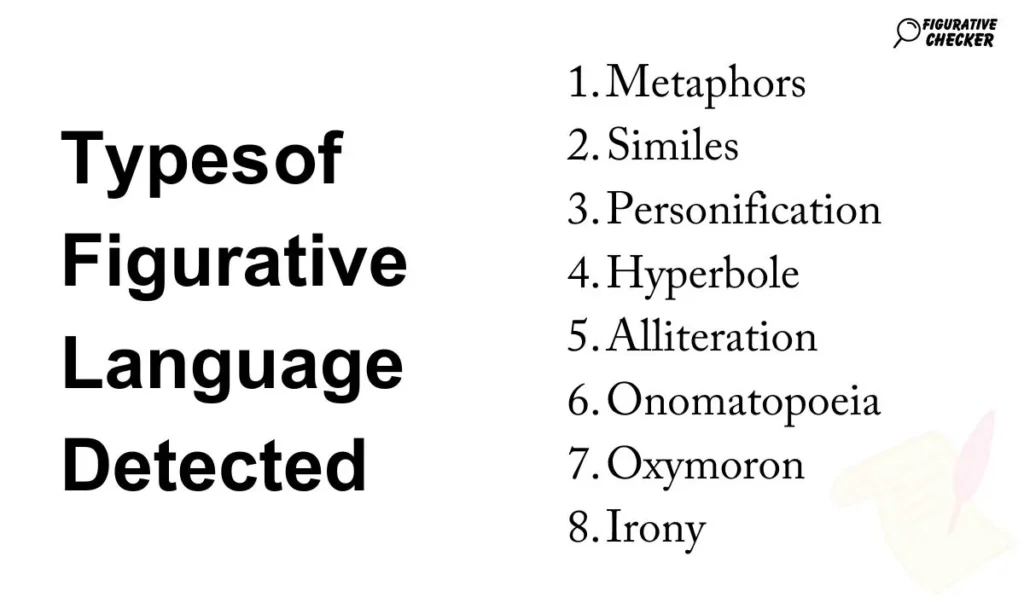
Simile:
This compares two things using “like” or “as.” For example, “I slept like a log” means you slept deeply—just like a heavy, unmoving log!
Metaphor:
This compares two things without using “like” or “as.” For example, “You are the light in my life” means someone brings happiness and guidance, just like a bright light.
Personification:
This gives human traits to non-living things. For example, “The moon smiled and hugged us with its warmth” makes the moon seem alive and friendly.
Onomatopoeia:
These are words that sound like what they describe. Think of “buzz,” “boom,” or “sizzle”—they make you hear the action in your mind!
Oxymoron:
This combines two opposite words to create a surprising effect. For example, “deafening silence” describes a quiet so intense it feels loud.
Hyperbole:
This is an exaggeration used to make a point or be funny. For example, “I’m so hungry I could eat a horse!” (Don’t worry, no horses are harmed!)
Imagery:
This uses words to paint a picture in your mind using the five senses. For example, “She is the sun” makes you think of brightness, warmth, and energy.
Allusion:
This is a reference to something famous, like a book, person, or event. For example, “to go down the rabbit hole” refers to Alice in Wonderland and means exploring something strange or unknown.
Idiom:
These are phrases that don’t mean what they say. For example, “having cold feet” doesn’t mean your feet are actually cold—it means you’re feeling nervous!
Litotes:
Litotes are a cool way of making a point by saying the opposite of what you mean but in a sneaky, understated way. It’s like saying something isn’t bad when you mean it’s great—or saying something isn’t great when you mean it’s terrible. It’s often used with a sarcastic tone, so it can sound funny or clever. Here are some examples:
- I can’t say I disagree with you. (Translation: I agree with you!)
- My dog is not the friendliest. (Translation: My dog is kind of mean.)
- He’s not even a little tired after staying up all night. (Translation: He’s super tired!)
- She’s not unkind. (Translation: She’s pretty nice.)
Synecdoche:
Synecdoche (pronounced si-NEK-duh-kee) is a fancy way of saying you’re using a piece of something to talk about the whole thing—or sometimes the whole thing to talk about a piece. It’s like saying “wheels” to mean a car or “the White House” to mean the President. Here are some examples:
- She’s got an awesome set of wheels! (Translation: She has a cool car.)
- The company needs more hands on deck. (Translation: The company needs more workers.)
- The White House issued a statement today. (Translation: The President or their team made an announcement.)
- The captain commands 70 sails. (Translation: The captain is in charge of 70 ships.)
Figurative language is like a secret code that makes writing colorful and fun. Once you understand it, you’ll see it everywhere—in books, songs, and even everyday conversations!
Figurative Speech And Examples
Figurative speech uses creative language to make writing more interesting and memorable. Instead of saying things literally, it paints pictures in your mind using comparisons or vivid images. Here are some common types with examples:
- Simile: Compares two things using “like” or “as” (Example: “She’s as brave as a lion.”)
- Metaphor: Says one thing is another to show a deeper meaning (Example: “Life is a rollercoaster.”)
- Personification: Gives human traits to non-human things (Example: “The trees danced in the wind.”)
- Hyperbole: An extreme exaggeration (Example: “I’m so tired I could sleep for a year!”)
- Irony: Saying the opposite of what you mean for effect (Example: “What lovely weather!” during a thunderstorm.)
Figurative Language Test Pdf
Here you can see answer key
Conclusion
Figurative language is a powerful tool for creating memorable and impactful writing. By leveraging figurative language checkers, writers, students, and educators can enhance their understanding and usage of literary devices, leading to more engaging and effective communication.
Whether you’re crafting a novel, analyzing literature, or creating marketing content, these tools can help you harness the full potential of figurative language. As technology continues to evolve, the integration of AI-driven language analysis will undoubtedly become an indispensable part of the writing and editing process.
So why not give a figurative language checker a try? Elevate your writing, spark your creativity, and connect with your audience on a deeper level.
People Also Ask
1. How can Figurative Checker make content more engaging for readers?
By offering suggestions on how to use figurative language more effectively, Figurative Checker can help writers craft more vivid, compelling content. Engaging writing often relies on clear, imaginative expressions, and the tool ensures that figurative language adds to the atmosphere or tone, helping to draw readers in and keep them engaged throughout the piece.
2. Can Figurative Checker be used for professional writing?
Yes, Figurative Checker can be used for professional writing. It helps identify figurative language in any form of writing, from academic essays to marketing materials, ensuring that the language used is appropriate for the intended audience. It provides feedback that can help improve clarity and tone.
3. How does Figurative Checker provide feedback on submitted text?
Figurative Checker analyzes the submitted text and highlights instances of figurative language. It then suggests whether the figurative language is effective, whether it could be made clearer, or whether it might be overused. Some advanced versions of the tool may also offer explanations of the figurative language and its impact on the writing.
4. Are there plans to expand the language capabilities of Figurative Checker?
While specific expansion plans vary, tools like Figurative Checker typically evolve to cover additional languages and more nuanced types of figurative expressions. If you’re interested in using the tool for languages other than English or for more complex figurative language, it’s worth keeping an eye on updates or contacting the developers for future capabilities.
5. How does Figurative Checker help improve academic writing?
Figurative Checker helps improve academic writing by using figurative language sparingly and appropriately. Overuse of figurative language can make academic writing feel less formal or unclear. The tool provides feedback on how to strike the right balance, ensuring that figurative language supports the argument or theme without distracting from the overall clarity and professionalism of the writing.
6. Is there a cost to use Figurative Checker?
The cost to use Figurative Checker varies depending on the version and the platform. Some versions may offer a free trial or basic features, while advanced features or subscriptions may require a paid plan. Always check the specific terms of service to understand the costs involved.
7. What makes Figurative Checker suitable for creative writers?
Figurative Checker is suitable for creative writers because it helps them refine their use of figurative language. Creative writing often relies on vivid descriptions and emotional appeal, and the tool can guide writers in choosing the right type of figurative language to enhance their storytelling. It helps ensure that metaphors, similes, and other devices are both effective and not overdone, creating a more engaging and polished narrative.
-
Creative Figurative Language Anchor Chart Examples
Figurative language is a cornerstone of effective communication and creative writing. It adds depth, imagery, and emotion to language, making it more engaging and relatable. However, teaching figurative language can be challenging, especially for younger students. This is where Figurative Language Anchor Charts come into play. These visual tools are designed to simplify complex concepts, making them…
-
Top Figurative Language Translators for Writers & Students
Figurative language is a cornerstone of human communication, adding depth, emotion, and creativity to both written and spoken words. It transcends literal meanings, allowing us to express complex ideas, evoke emotions, and create vivid imagery. From Shakespeare’s metaphors to modern-day advertising slogans, figurative language enriches our interactions and storytelling. However, translating figurative language poses unique…
-
Fragment VS Complete Sentence: Mastering Sentence Structure for Clear Writing
3 Topic Discuss Types of sentence fragments Understanding the difference between sentence fragments and complete sentences is crucial for effective communication. Whether you’re writing an academic paper, a business report, or a creative piece, knowing how to construct complete sentences and avoid fragments can significantly enhance the clarity and professionalism of your writing. This article…
-
Figurative Language Posters for the Classroom: Engaging, Educational & Creative
Figurative language posters are a fantastic addition to any classroom, providing visual cues to help students grasp complex literary concepts. These engaging tools can transform a learning environment, making it vibrant and educational while reinforcing key language arts concepts. Engaging Guide About this Topic What is Figurative Language? Figurative language is a literary device used…
-
Figurative Language Finder: Your Ultimate Guide to Literary Devices
Figurative language is a fundamental element of effective communication, especially in literature, poetry, and creative writing. It helps writers convey meanings, evoke emotions, and create vivid imagery. However, identifying figurative language can be challenging for readers and writers alike. This comprehensive guide will explore figurative language types, their significance, and how a “Figurative Language Finder”…
